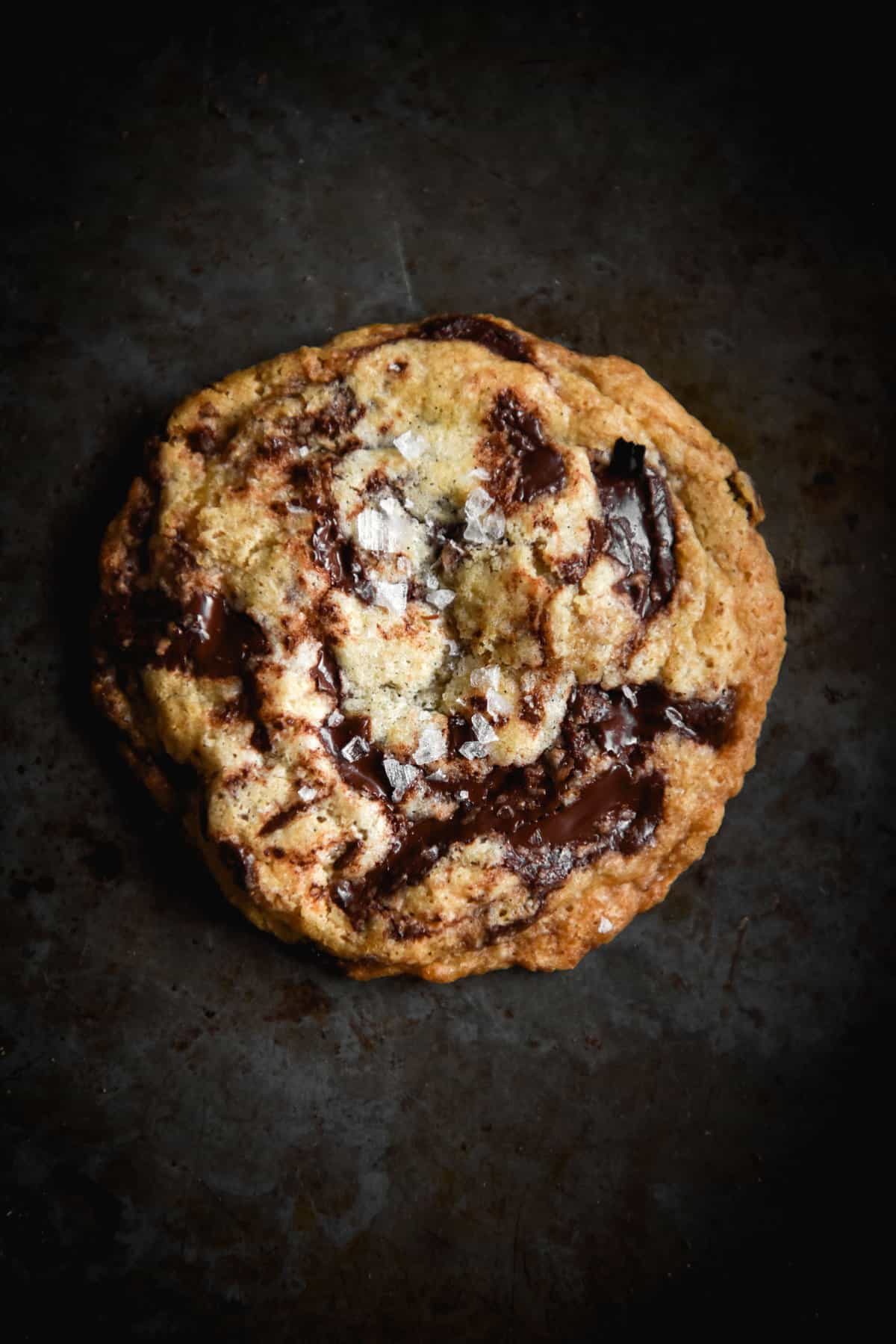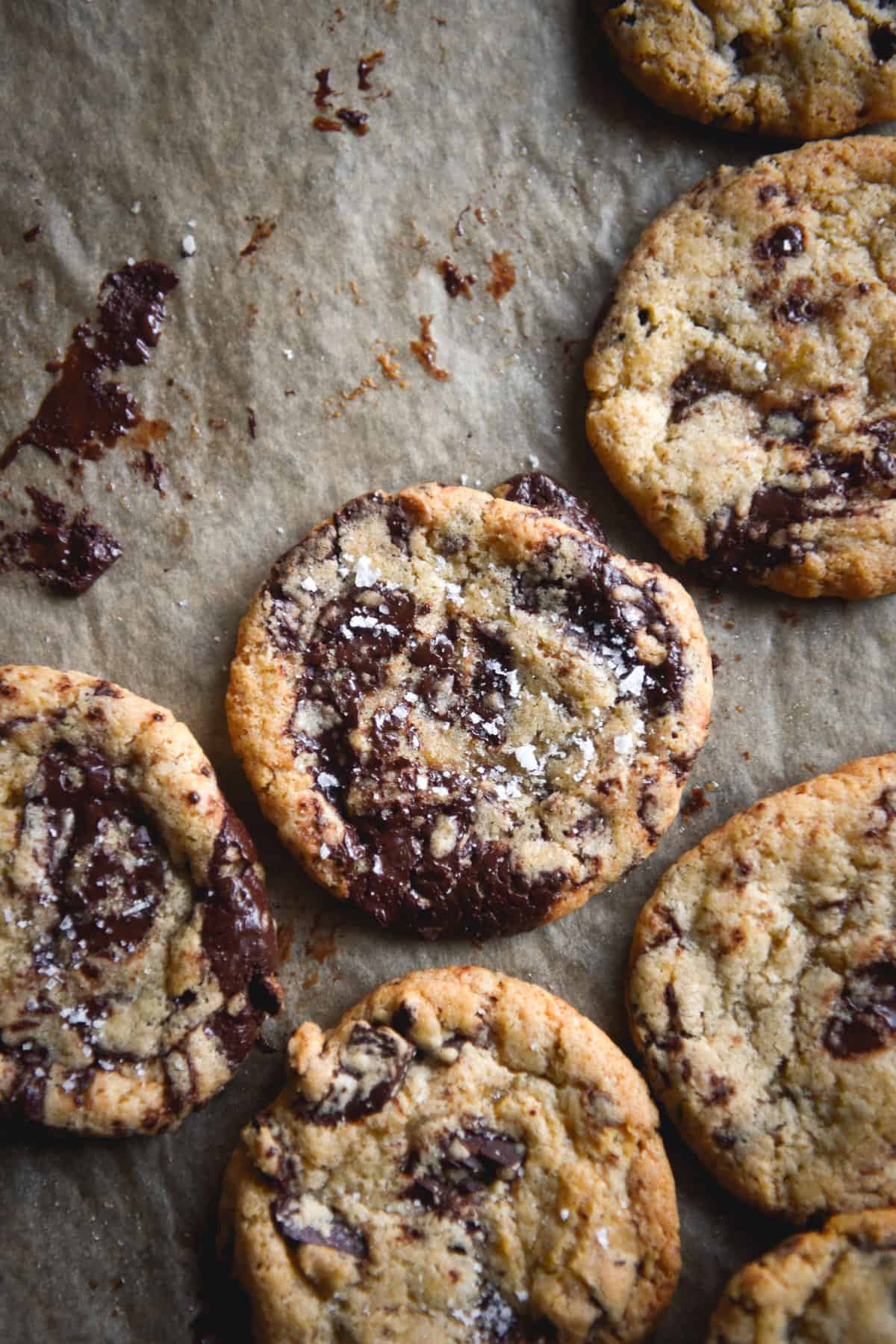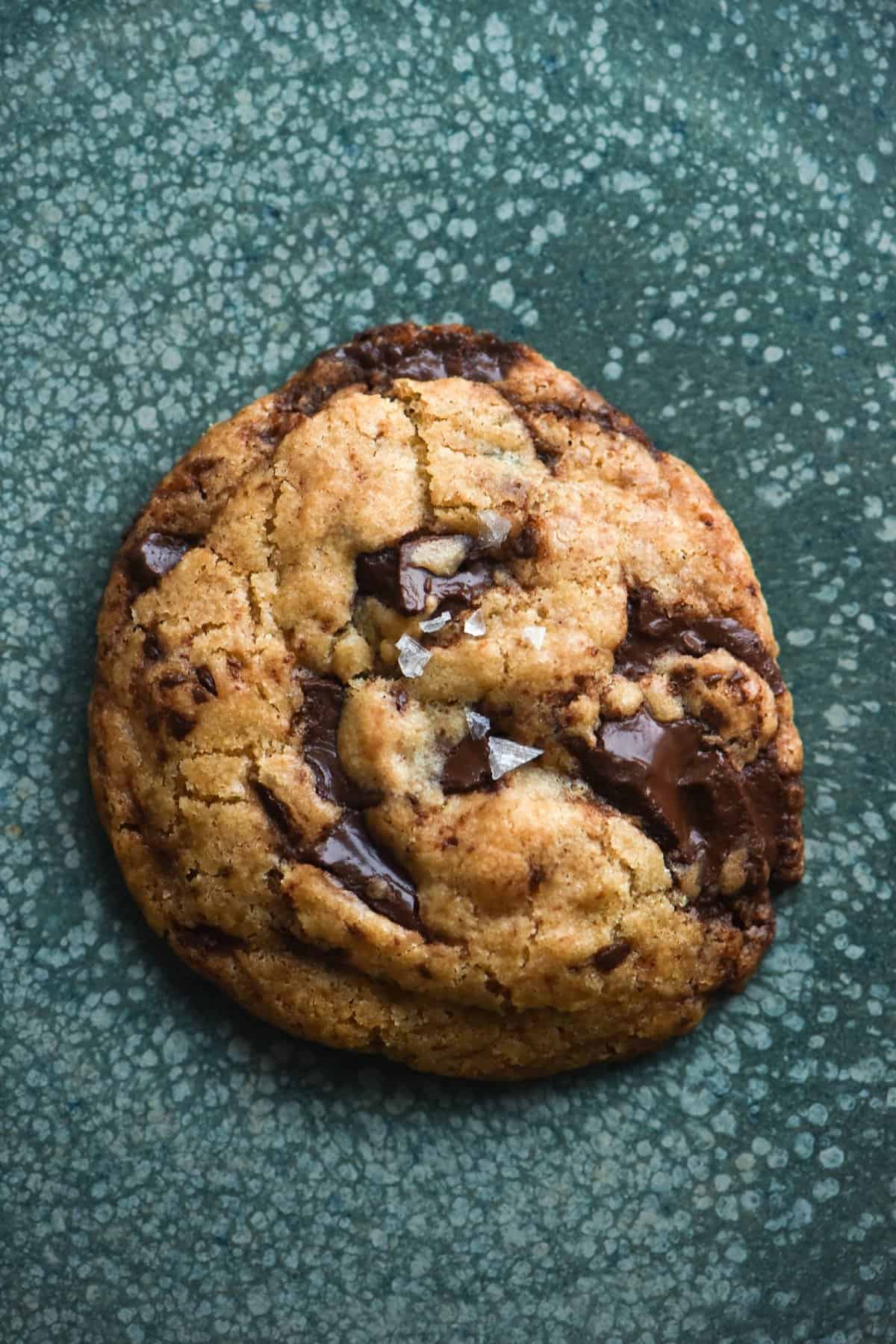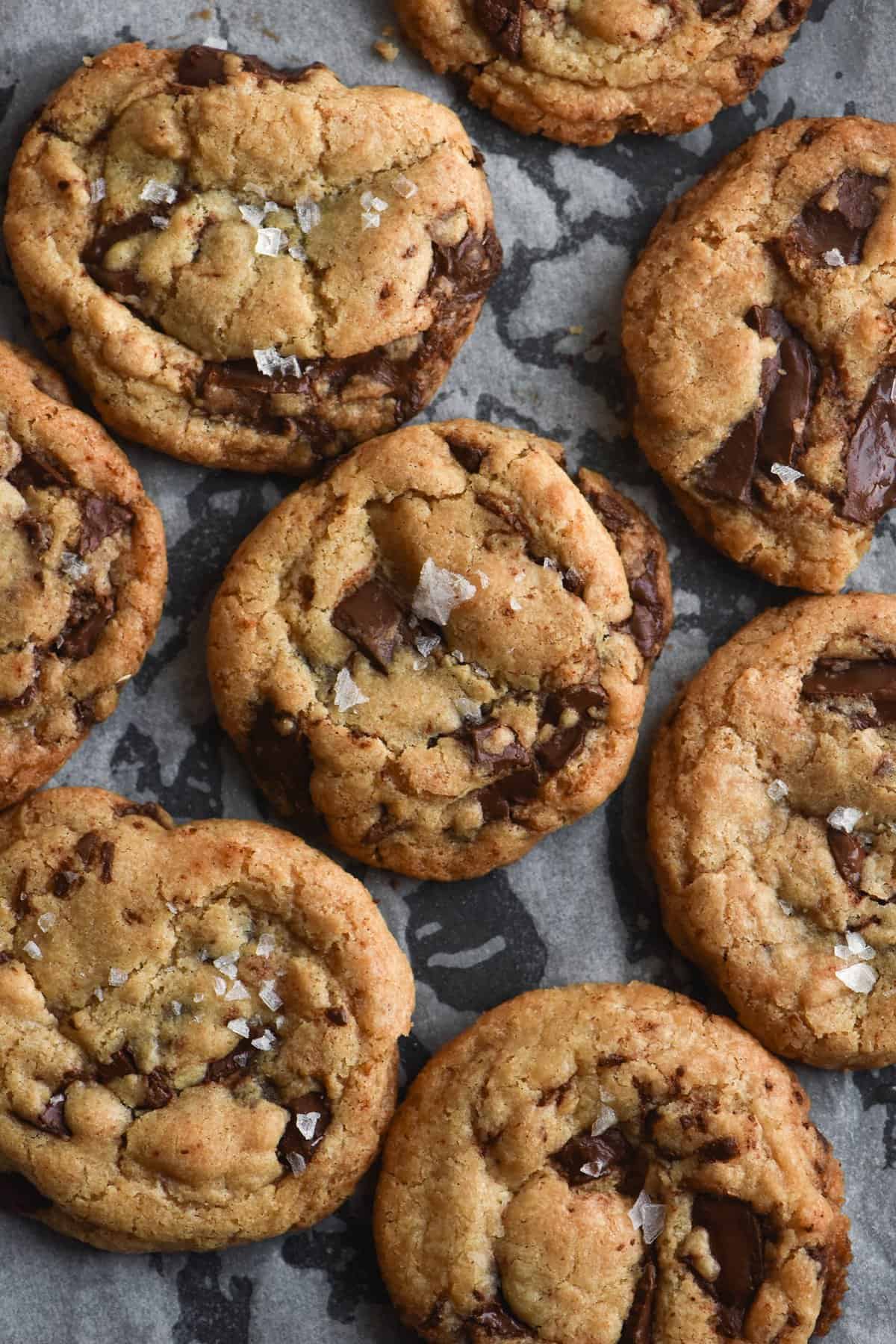
After realising that my favourite version of the recent brownie was in fact the vegan variety, I have had a vegan baking epiphany. There’s something so triumphant about creating cookies that seemingly shouldn’t be able to exist. AKA: vegan chocolate chip cookies, that are also gluten free, nut free and FODMAP friendly. No egg substitutes, no fancy gums, no fancy flour blends. Just simple, easy to find ingredients, and a lot of chocolate. Everybody wins!
Vegan gluten free choc chip cookies
Before we begin, let me clarify the type of cookie this is. It is a chewy, thin cookie with crunchy, sugary edges. It flattens out in the oven, and doesn’t have enormous height to it. I wanted to get as close to a Subway cookie as possible. If you’re on the market for a vegan chocolate chip cookie that is puffy, cakey or tall, please look away, or at least look elsewhere.
It is also, dare I say, the most diva of diva vegan, chocolate chip cookies. The Mariah of cookies. You will need to have your wits and your intuition about you, which is worth it for the cookie that shouldn’t exist. Strap yourselves in friends, this is quite the ride, and quite the essay.
Ingredient notes for these vegan gluten free choc chip cookies
Vegan butter
First and foremost, we’re using vegan butter. This one ingredient has such a huge impact on the cookies that it deserves it’s own paragraph. Vegan butter has a much higher water content than regular butter. Liquid in cookies is responsible for spread, so we need to use some measures to stem the spread, as we will discuss. In addition, no two vegan butter brands are the same, and as such, each will impact your vegan cookies in different ways. Learning how to adapt to fat and liquid contents is important for successful vegan and gluten free cookies.
The most important tip I can give you is to choose the vegan butter brand with the highest fat content possible. I have used Nuttelex Buttery in the majority of my tests, which has 65g of fat per 100g of butter. According to my research, anything above the 70g of fat per 100g is ideal. DO NOT use low fat, or you’ll end up with one giant flat mess.
Another thing to note is that creaming vegan butter is quite different to regular butter. I found only anecdotal evidence to support my theory, but I found that creaming the butter COLD AND STRAIGHT FROM THE FRIDGE to be vital in achieving a good vegan cookie. Whether the liquid and fat separate when creamed warm, I’m not sure. All I know is that I had a lot more flat cookies when using room temperature vegan butter, and a few other websites have said the same.
Baking powder
While regular cookies rely on baking soda, we’re using baking powder. The internet tells me that baking soda is responsible for spread in cookies, while baking powder is responsible for rise. We have a number of very spready ingredients in these cookies – margarine, tapioca flour and white sugar. To stem the spread and encourage some lift and thus crinkle, we use baking powder only.
Sugars
We are using predominantly brown sugar for this recipe. Each cookie recipe varies according to it’s ultimate goal (light brown sugar provides a caramel flavour and browning, whereas white sugar promotes spread.) As we’ve mentioned a few times now, we have a lot of spready ingredients, so using predominantly brown sugar keeps the vegan butter and gluten free flours in check. Brown sugar also gives a delicious, full flavour to cookies, whereas I find white sugar cookies to be rather one dimensional.
Gluten free flours
I like to keep the flours simple and accessible, so I have used tapioca flour and brown rice flour. While white rice flour can kind of work as a substitute to brown, I find that the tops of the cookies are a little translucent when doing so. Brown rice flour provides a nice heavy and crispy base, while tapioca flour promotes spread, lightness and a neutral flavour. Within 60 bloody tests, I found that different brands of the same type of flour (or one bulk food store vs the other) can make a big impact on the final cookie. When testing, I ran out of one variety of brown flour and moved onto the next, only to pull out a fat puffy cookie, where the first one had spread beautifully. We’ll discuss more in the ideal method section, but be prepared to use your intuition.

Tips for making vegan gluten free choc chip cookies
Weigh the ingredients. This is so important that I haven’t even included cup measurements. Cookie making is an art at the best of times, but VEGAN AND GLUTEN FREE COOKIES? Sorry not sorry, these cannot be made without scales. They are inexpensive and pretty vital for niche baking.
Start the cookies the night before you intend to bake them. The flavours mellow, the liquid absorbs into the flours, and you are much more likely to get that coveted wrinkly but crispy golden brown cookie.
Don’t skip the salt! The salt is absolutely integral in balancing the sweetness of these cookies. Without the salt, the flavour profile is just ‘sweet.’ With the salt, they have a nuanced, rounded flavour profile. Don’t skip it.
Be prepared to go rogue a little. As we discussed above, there are a lot of moving parts here.
Never put cookie dough on a hot tray. This will start the spreading process and does nothing to avoid your cookies melting into one cookie. Use alternating baking paper lined pans, and allow them to cool between each use.
Don’t overcrowd the cookies on a tray, and don’t spoon huge cookies. Huge cookies spread more and brown less. You can guess what happens if you overcrowd the pan.
I suggest cooking the first cookie alone, to make sure you’ve got the texture right. If it doesn’t spread at all, add a teaspoon of extra soy milk, if it spreads far too much, add 5g extra of tapioca flour. More on this in the troubleshooting section.
Have patience! Even if you don’t get them to spread on the first go, they’ll still be delicious. Cookie making is an art, and I’m surprised we don’t recognise that more.

Ingredient notes for the vegan gluten free choc chip cookies
- I have written a bit about vegan chocolate in the vegan brownie recipe, but I will repeat some things here. I have used Lindt coverture dark chocolate chips for all of the tests of these cookies. They melt extremely well, are delicious, and happen to be vegan. They are available at bulk food stores in Australia, and assumedly online. I have not tried coconut oil based chocolate in this recipe, and don’t intend to. Let me know if you do and it works for you.
- For basically everything you need to know about cooking with chocolate (including googling coverture like I have done many times now) click here.
- I buy my flours from Source Bulk Foods to save on unnecessary plastic. I also like Terra Madre in Northcote (if you’re from Melbourne) and the Organics shop on Smith Street, both of which sell bulk flours in cardboard type bags.
- When buying rice flours, make sure they are super finely ground. Gritty rice flour is super noticeable in things like cookies, particularly vegan ones.
- Generally I find supermarket rice flour quite gritty, although it is available at the supermarket, if thats the only option available to you.
- I use vanilla paste from Terra Madre, or Queen Vanilla paste from the supermarket, if I’m in a pinch. I found some others to be quite runny and thin. The vanilla adds not only moisture but great depth of flavour which helps mask the vegan butter flavour. I don’t recommend omitting it.
- On the topic of things not to omit, don’t omit the sea salt flakes! They add a welcome contrast to the sweetness, and help mask the vegan butter.
- Because they are basically constructed of sugar and fat, the cookies don’t have any real FODMAP concerns.

Vegan gluten free choc chip cookie science
I thought this knowledge would be helpful to be out into the world wide web, if only for me to refer back to when I forget it in a week.
A quick rundown of the function of our main ingredients in these cookies.
- Caster sugar spreads and melts, so it is crucial for a melty sort of cookie.
- Brown sugar leavens a cookie, giving it crunch and rise, as well as complex flavour and browning. Rise is important, because in the case of vegan cookies, we don’t have eggs to help leaven.
- Tapioca flour spreads, and is also a nice neutral, light flour base for the cookies. Gluten free flours in cookies can get quite gritty, so tapioca plays a pivotal role in keeping that to a minimum.
- Brown rice flour stops cookie spread. It is is a nice, stable base for the tapioca, making the flour combination more akin in quality to regular flour. It can be gritty, so I find it best to keep it as the minority flour.
- Baking powder gives a cookie rise, while baking soda gives it spread. In this recipe, the tapioca flour and margarine do a lot of the spreading, so we don’t use any baking soda.
So, tapioca spreads, and brown sugar rises. One way to make these vegan chocolate chip cookies your own is to play with these two ingredients, upping and lowering them simultaneously. For example, if you like a puffy cookie, you could try adding a little extra brown sugar (and the corresponding amount less caster sugar) and a little less tapioca flour (with the corresponding amount extra brown rice flour)
Helpful resources for cookie making
This section is as much about helping you as it is a selfish collation of all the articles I found so I don’t have to search for them again.
- This article is what first got me into the wild world of cookie science. I remember being in awe of how somebody could be so obsessed with perfecting a cookie. I get it now.
- This article gives a good run down of the qualities each ingredient brings to the table. It focuses on regular wheat flour cookies, but there’s still a lot of helpful information as you try to wrap your head around what does what.
- This ultimate cookie guide from Handle The Heat was very helpful, particularly as I first delved into the science of cookies. There are four parts to it and I recommend reading them all. The pictures are v helpful.
- This Buzzfeed article provides another good rundown if you’re just starting out on your cookie journey.
- Some general cookie science (probably best for the well versed in cookie making)
- This site has some good tips on how to create a rippled cookie. Again, this focuses on wheat flour cookies, but there are some good tips there all the same, particularly as you become an advanced cookie maker.

Troubleshooting your vegan gluten free choc chip cookies
If your cookies are flat:
Did you weigh the ingredients as per instructions? Are you using cold vegan butter? Did you cream the butter for the allotted time? Were your cookies chilled overnight? If not, you know what to do.
Other things that can affect cookies include the colour/make of the oven trays and ovens that run hot/cold. Something to keep in mind.
The fat content of your vegan butter substitute matters enormously. Use the highest fat percentage possible (ABSOLUTELY NO LOW FAT VARIETIES PLEASE) – Nuttelex Buttery is 65g of fat per 100g. Lower fat margarines have higher water contents, which will cause your cookie to spread.
Spooning too large a cookie can create too much spread, so make sure you use rough tablespoon measures of cookie dough.
If all of the above have been covered, add 5g of tapioca flour to your dough at a time. As we discussed, the qualities of gluten free flours can vary batch to batch.
If your cookies are too puffy:
Add a teaspoon extra of soy milk, and cook one cookie to check that they’ve de-puffed. I should note that the puffy version is still delicious, just different.
If the cookies didn’t spread the way you wanted them to:
Spready, crinkly cookies are created by using a higher fat to flour ratio than usual. Although the rules are all very different and wacky when it comes to vegan cookies, try using 5g less tapioca flour in increments and see where that leaves you. As mentioned above, if they’re too puffy, add a little extra soy.
Have a look at your vegan butter, and make sure the fat content is high enough.
If the cookies didn’t brown the way you wanted them to:
First one is quite obvious – try cooking them a little longer. You’d be surprised how much can change in 1-2 minute increments in the oven. Just don’t go too far or they will lose their inner chewiness and become completely crispy. I’d say 2-3 extra minutes max.
You can add a small pinch of baking soda to encourage browning. Just be aware that it might make them spread a little. In that vein, make sure a small pinch is a small pinch – any more and you’re at risk of getting a metallic taste and flat vegan chocolate chip cookies.
More gluten free vegan dessert recipes
- Gluten free vegan sticky toffee pudding
- Easy gluten free vegan chocolate cake
- Vegan, gluten free cinnamon rolls without yeast
- Gluten free vegan blueberry muffins
- Gluten free vegan brownie cookies

Vegan gluten free choc chip cookies
Ingredients
- 75g COLD vegan butter (needs at least 65% fat per 100g, I used Nuttelex Buttery for all my tests)
- 50g light brown sugar
- 25g caster sugar
- 2 tsp vanilla bean paste (I use Queen because it's nice and thick)
- 2 tsp cold soy milk (I used Bonsoy)
- 55-70g tapioca flour (read notes carefully)
- 30g brown rice flour (make sure it's finely milled)
- 1 tsp baking powder
- 1/4 tsp fine salt
- 50-100g vegan chocolate (I used Lindt dark, I haven't tried a coconut oil based one)
- sea salt flakes, to finish
Instructions
The night before:
- Weigh the sugar and COLD vegan butter out. It should come straight from the fridge, and have been there overnight beforehand. Please don’t pop it in ten minutes before creaming and then ask me why they didn’t work.
- Place them into the bowl of your kitchen mixer. Add the vanilla bean paste and cream for 1 minute on a high speed. I use my whisk attachment and cream on speed 6 on a Kitchenaid.
- Use a spatula to wipe down the bowl edges, making sure there’s no rogue butter or sugar there. Cream for another minute. The mixture, while the whisk attachment is whisking through it, should look like a light coloured cookie batter already. The whisk should leave tracks.
- If you live in a hot climate or a summery one (I tested this in the depths of winter) consider transferring the vegan butter mixture to the fridge while you weigh the flours out.
- Weigh the flours, baking powder and salt into a small bowl. Use a clean, dry whisk to thoroughly combine.
- Remove the butter mixture from the fridge, and measure out the COLD soy milk. I use soy milk. Mix the soy milk into the butter mixture until the edges pull away from the bowl.
- Add the flour mixture to the butter, ensuring you get every little bit. Even 5g deviation in these cookies makes a huge difference. Use a spoon to mix until the cookie dough comes together and is just too wet to handle. Make sure you scrape up every bit of flour from the sides of the bowl.
- I like to transfer the cookie dough back into the flour bowl (which is small and fridge friendly) and cover it to refrigerate overnight. Anecdotally, I found that the vegan chocolate looks prettier and melts more dramatically if you mix it into the cold dough, just before cooking.
The next day:
- Preheat the oven to 180C or 356F.
- Chop the chocolate (texturally and visually far more interesting) and stir through the cookie dough. Anedotally, I have found that putting the oven tray into the freezer for 10 or so minutes before use can help stop excess cookie spread.
- I recommend cooking 1 cookie solo first, just to check that the cookie is exactly what you want. This way, you can easily adjust and proceed. If the cookie is flat, see the flat troubleshooting section, and if you tick everything off, add 5g extra tapioca flour. To address a puffy cookie with no spread, add 1 extra teaspoon soy milk, and bake off another cookie.
- If you're happy with the cookie consistency, place 4 X 1 tablespoon balls of cookie dough evenly across the tray. They will have shaggy edges (you can't roll this dough with your hand) but thats fine. Put them in the oven for 10 minutes. When you open the door, they should have spread and puffed up. Gently bang the tray on the oven rack to release the gas in the cookies and create rippled surfaces. Cook them a little longer if they need darkening – only 1-2 minutes, so they're still crispy inside.
- Repeat with the remaining cookies on a cold tray.
- Allow them to sit on the tray for a minute or so, before gently transferring the baking sheet onto a cool surface. Don’t pick them up for AT LEAST five minutes – they are molten sugar without an egg to bind, and need time to cool.

These chocolate chip cookies look simply incredible! So chocolatey and delicious ♥
Thanks Natalie! 🙂
Seriously Georgia you’re a cookie goddess. This is an insanely good post (and not just for the fact that you’ve thought of bloody EVERYTHING when it comes to GF + vegan cookies!) Those article links are great, as I’m relatively new to the Frankenstein-style recipe development that is the world of vegan and GF baking! Thanks so much for all the hard work you put in to make our lives easier!
Wooooaaaaah ! So I just read this article/recipe, and I’m amazed by it’s content. First of all, I wanna say thank you so much for sharing your research/knowledge about cookies. I’ve been trying to bake the perfect cookie, but it’s been quite a journey, and I think this recipe/article is a mine gold and will help me so much.
So once again, thank you for your incredible work. This is truly amazing ☺️
Can I replace almond flour for the rice flour?
I haven’t tested it but I think it would drastically alter the results. There are lots of grain free almond meal cookies on the internet, I think for best results you’d be better trying a recipe tailored to almond meal 🙂
How many cookies does this make?
Hello, do you think replacing coconut oil or avocado oil instead of butter will work?
Hi Anshita, unfortunately it won’t. They don’t perform in the same way as butter so I daresay they would spread excessively. They would also be too oily. I’m working on some oil based cookies though I will keep you posted!
really good! However, mine spread out a lot and even though i added extra flour, however, I did not freeze the cookies, so maybe that’s why. But overall flavour is really good!